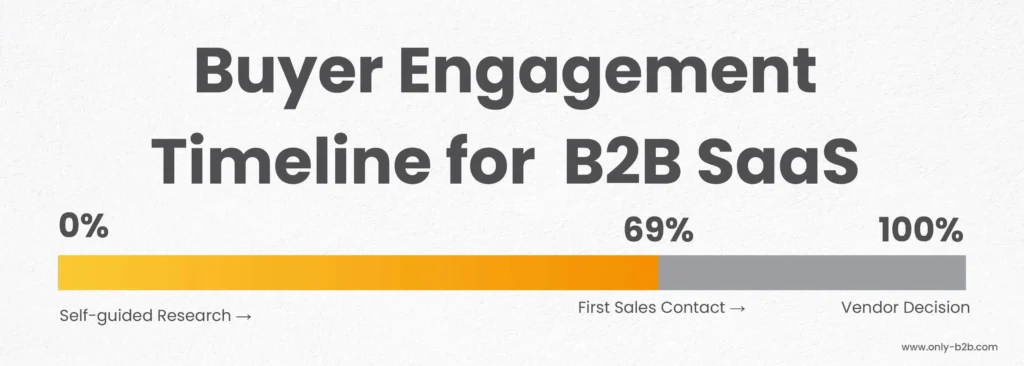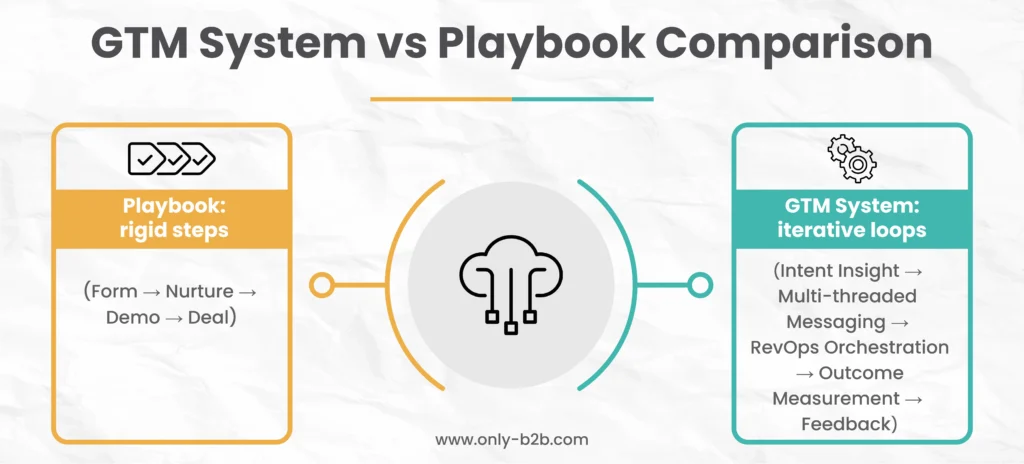The Playbook is Dead. Build the System.
You’ve built a stunning SaaS product. But you’re only halfway there. The real win happens when your product finds the right audience and resonates deeply.
Today’s buyers are sophisticated, AI-augmented, and firmly in control of the sales process. Yet revenue teams are still operating on broken foundations: outdated KPIs, channel-first tactics, and fragmented execution. What’s needed isn’t just an updated playbook. It’s an entirely new system.
If you’re wondering how to craft a winning go-to-market strategy in B2B marketing, this blog is your starting point.
This blog explores why most GTM strategies fail, what’s changed in the market, and how to build a resilient, adaptive GTM system for 2025.
Let’s dive in.
What’s Changed in B2B SaaS GTM
Table of Contents
Buyer-Led Journeys Bypass the Funnel
Over 80% of buyers finalize mid‑market SaaS decisions within six months, often bypassing early vendor contact entirely (G2 Learn).
Generative AI Reshaping the Field:
More than 100 mid‑market software firms face existential risk as AI‑native competitors reshape pricing and product models (Business Insider).
AI ROI Is Now Expected
Nearly two‑thirds of B2B revenue leaders in Europe report ROI from AI within one year; buyers expect speed and relevance from the outset (IT Pro).

Why a New GTM Framework Is Non-Negotiable in 2025
The MQL Is a False Signal
MQLs make dashboards look busy, but they rarely signal intent. Overreliance on lead volume (vs. lead quality) bloats your CRM and fuels tension between marketing and sales.
Instead, the new GTM lens focuses on:
- PQL (Product-Qualified Lead) Velocity
- ARR (Annual Recurring Revenue) Progression
- NRR (Net Revenue Retention) Health
- CAC (Customer Acquisition Cost) Payback Periods
These metrics bloom in actual business and force alignment across revenue teams.
Modern Buyer Rejects Generic Everything
Buyers today are AI-powered, community-driven, and time-constrained, and they won’t tolerate generic outreach or slow, disconnected experiences.
Yet many teams cling to static email nurtures or product pages that speak to everyone, but no one in particular. Modern GTM requires personalization at scale. Not just in names, but in messaging, channels, and timing.
What If You Designed Your B2B SaaS GTM for Today?
Operational misalignment remains a top GTM killer. If RevOps isn’t centralized:
- Marketing operates in isolation
- Sales builds its own pipeline
- Customer success has no say in acquisition
This disconnected approach creates friction in handoffs, lost context, and delayed responses. It is especially fatal when you’re competing against agile competitors.
A successful GTM system requires RevOps not as a backend function, but as a strategic focal center. It should drive data integrity, process efficiency, and cross-team alignment.
Retention Is Now a GTM Motion
Still treating expansion as post-sale? That’s outdated.
Retention and upsell should be part of pipeline forecasts, not afterthoughts. Your lifecycle orchestration must include CS in messaging, planning, and attribution. And this is where sustainable growth happens.
Core Pillars of a Modern B2B SaaS GTM Strategy
A modern GTM system must be built around adaptability, alignment, and revenue precision. Here are the essential building blocks:
1. Clear ICP & Intent-Based Segmentation
What’s the most common and costly GTM mistake? It’s targeting a broad or ill-fitting ICP. Many teams start with firmographics like company size or industry, but ignore behavioral signals.
The results? Poor-fit leads and low conversion. Even worse, internal alignment suffers when sales and marketing define ICPs differently.
The goal should be to move beyond static personas and build dynamic ICP frameworks based on intent signals, engagement patterns, and usage data. You’ll need AI tools to detect micro-niches and prioritize accounts most likely to convert.
Your segmentation should reflect real behavior, not just spreadsheets. Precision here means better messaging, smarter outreach, and more effective GTM motions.
2. Multi-Threaded Messaging
One message won’t land with all stakeholders. That’s because buying committees often include champions, blockers, influencers, and decision-makers.
Each has different priorities and pain points. Generic messaging, or failing to map content to buyer stages, is going to stall your deals.
Marketers’ role here is to build multi-threaded messaging strategies. This requires you to equip your GTM team with persona-specific narratives.
Leverage sale enablement tools to deliver content that speaks to each stage, from first touch to negotiation. Nuanced messaging means better outcomes.
3. Revenue Team Alignment via RevOps
What does a team going wrong look like? Teams chasing disconnected goals: marketing wants MQL volume, sales want SQLs, CS want renewals. Everyone’s rowing hard, but in different directions, sinking your revenue.
RevOps is the glue. It unifies systems, data, and accountability.
To drive alignment:
- Centralize ownership of funnel transitions
- Automate handoffs and workflows
- Enforce shared KPIs like PQL velocity, pipeline progression, and NRR
With RevOps at the core, your GTM system becomes a wheel and spins faster with alignment.
4. Outcome-Based Measurement
Too many SaaS teams stick to easy and comfortable metrics like web traffic, CTRs, and email opens. Surely, they feel productive, but do they add bucks to your revenue? This only leads to a misallocated budget and poor decision-making.
In the world of B2B SaaS demand generation, such vanity metrics can distract from what truly drives growth.
Refocus your GTM dashboard on outcomes that matter:
- CAC payback: Are you acquiring customers efficiently?
- PQL conversion rate: Are trial users becoming buyers?
- NRR and expansion MRR: Are existing customers growing?
- Churn trends: Are there signals you’re ignoring?
These metrics are gold. Use them to inform motion prioritization, campaign design, and product feedback. GTM today is about revenue accuracy, not volume.
Choosing the Right GTM Motions
Now you ask: which is the “best” GTM motion? There is no universal answer. Success depends on context, your product complexity, deal size, buyer sophistication, and sales cycle length.
Yet many GTM motions never move out of two words: inbound or outbound, without understanding what really delivers.
Here’s how to think about each motion:
Inbound:
Great for PLG or awareness-stage buyers. But it’s a long game. Teams that expect quick wins often pull the budget prematurely. Optimize SEO, thought leadership, and conversion paths that guide rather than gate.
ABM:
Ideal for high-ACV or strategic accounts. The challenge is orchestration. Without sales, marketing, and product working together, ABM falls flat. Invest in targeting tech, personalized content, and cross-functional pods.
PLG:
Dominant for developer-first or self-serve SaaS. But many PLG motions fail when they ignore the onboarding experience or sales-assist strategy. Align GTM teams to support activation, not just acquisition.
Outbound:
Powerful for targeted personas, but expensive and execution sensitive. Many SDR teams burn out due to poor data or a lack of personalization. Solve with high-quality ICP, AI enrichment, and enablement.
Dark Social:
Hard to measure, easy to ignore. But your buyers are influenced daily by what’s shared in Slack groups, Discord, or DMs. The solution isn’t to “track” dark social but to participate in it. Be where the conversation is.
In simple words: match motions to your business reality, not your competitors’ playbook.
Channel Strategy: Where Mid-Market Buyers Actually Buy
A key to cracking SaaS GTM is knowing where influence happens. Most GTM teams are still busy digging their channels like ads, emails, and webinars. But today’s buyers live in places that don’t show up in attribution reports.
Modern SaaS buyers rely heavily on:
Organic Search:
It’s still king for discovery. But most teams underinvest in bottom-funnel content. Prioritize case studies, comparison pages, and technical how-to’s.
For a deeper look at what works at each stage, check out our B2B SaaS funnel guide.
LinkedIn:
Not brand posts, but peer shares and employee voices. Build internal influence through SME advocacy and thought-leader enablement.
Communities:
Places like RevOps Co-op or Modern SaaS Collective are driving high-value conversations. But this isn’t a place to sell. Engage, share, and be useful.
Direct Ads:
Saturated, but still valuable when layered with other motions. Use for remarketing or competitive capture, not as a standalone act.
Fix attribution with multi-touch modeling, reverse IP tracking, and customer journey mapping. Use insights, not just data, to understand what drives revenue.
What GTM Success Looks Like Today

Winning isn’t about who follows the best playbook. It’s about who builds the most adaptive, aligned, and accountable system.
Modern GTM success demands:
- Anchored in real buyer behavior
- Powered by RevOps
- Measured by outcomes, not activity
The go-to-market path is clear but no longer a linear sequence. It’s a living system that learns, adapts, and scales with precision.
Rethink your strategy and win the market before your competitors do.

Vikas Bhatt is the Co-Founder of ONLY B2B, a premium B2B lead generation company that specializes in helping businesses achieve their growth objectives through targeted marketing & sales campaigns. With 10+ years of experience in the industry, Vikas has a deep understanding of the challenges faced by businesses today and has developed a unique approach to lead generation that has helped clients across a range of industries around the globe. As a thought leader in the B2B marketing community, ONLY B2B specializes in demand generation, content syndication, database services and more.





